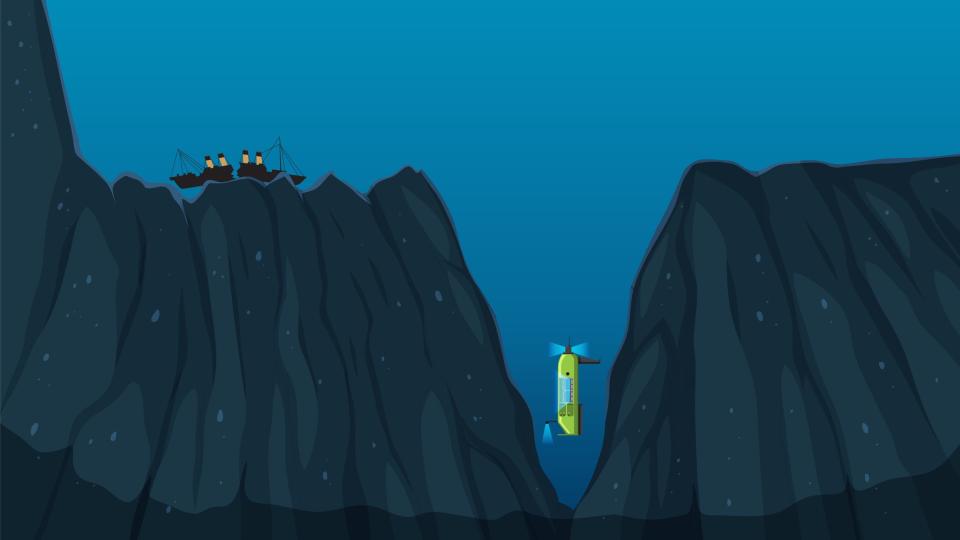How deep is the ocean? Deeper than the highest point on Earth's surface, by more than a mile

The ocean is significantly deeper than the highest point on Earth's surface.
The Titanic is farther down than the deepest-diving mammal, the Cuvier's beaked whale, ventures.
Even this wreck doesn't come close to the deepest-crewed mission that reached 35,839 feet in 2019.
This article is primarily transcribed from a 2017 Insider video: "This incredible animation shows how deep the ocean really is." Some of the information has been updated.
Just how deep does the ocean go? If you took the highest point on land and submerged it, you would still have more than a mile between you and the deepest point in the ocean.
The oceans harbor 99% of all living space on Earth and have enough water to fill a bathtub that's 685 miles long on each side. To compare, the state of California is about 720 miles long.
For scale, the average height of a human is about one-sixteenth the typical length of a blue whale — the largest animal on Earth. Blue whales usually hunt at depths of around 330 feet, within the well-lit zone of the ocean.

Deeper down, at 700 feet, the USS Triton became the first submarine to circumnavigate the Earth in 1960.
At 831 feet, we reach the deepest free dive in recorded history by the Austrian-born diver Herbert Nitsch. The pressure is 26 times greater here than at the surface, which would crush most human lungs. But blue whales manage it when they dive to a max depth of 1,640 feet to hunt giant squid.
Fifteen minutes after the dive, Nitsch developed severe decompression syndrome which led to multiple brain strokes. However, he recovered inside a hyperbaric chamber and ultimately survived to tell the tale.
At 2,400 feet, we reach the danger zone for modern nuclear-attack submarines. Any deeper and the submarine's haul would implode.
Reaching 2,722 feet down is where the tip of the world's tallest building, the Burj Khalifa, would reach. A little farther at 3,280 feet, we're deep enough that sunlight can't reach us. We've now entered the midnight zone.
Many animals down here can't see, such as the eyeless shrimp at 7,500 feet which thrive near scalding hot underwater volcanoes.

At this depth, temperatures are just a few degrees above freezing, but the water around hydrothermal vents can heat up to 800 degrees Fahrenheit.
Around 9,816 feet is the deepest any mammal has been recorded swimming — the record was set by Cuvier's beaked whale.
But not even Cuvier's beaked whales could explore the wreck of the Titanic, which rests at a staggering depth of 12,500 feet.
The pressure is now 378 times greater than at the surface. Yet you can still find life like the fangtooth hagfish and dumbo octopus, the deepest-living octopus on Earth.
At 20,000 feet is the hadal zone, an area designated for the ocean's deepest trenches, such as the Mariana Trench.

If you tipped Mount Everest into the Mariana Trench, its summit would reach down to 29,029 feet — that still doesn't compare to the two deepest-crewed missions in history.
In 1960, oceanographer Jacques Piccard and Lt. Don Walsh descended to the lowest point on Earth, the Challenger Deep, at a record 35,797 feet below the surface.
They held the record for decades until the explorer Victor Vescovo came along in 2019. Vescovo made three dives to the Challenger Deep that year and set a new record on the third dive, reaching a depth of 35,839 feet.
Scientists have sent half a dozen unmanned submersibles to explore the Challenger Deep, including Kaiko, which collected more than 350 species on the seafloor from 1995 to 2003. But scientists estimate there are potentially thousands of marine species we have yet to discover.
Humans have explored an estimated 5% to 10% of Earth's oceans. We've only just begun to understand the deep, dark world that flows beneath us.
Watch the original video here:
Correction June 27, 2023 — An earlier version of this story misstated when the diver Herbert Nitsch experienced decompression sickness. It happened 15 minutes after his record dive was complete, not during the dive. The article also misstated the record depth that Jacques Piccard and Don Walsh reached. It was 35,797 feet, not 25,979 feet.
Read the original article on Business Insider

 money
money 